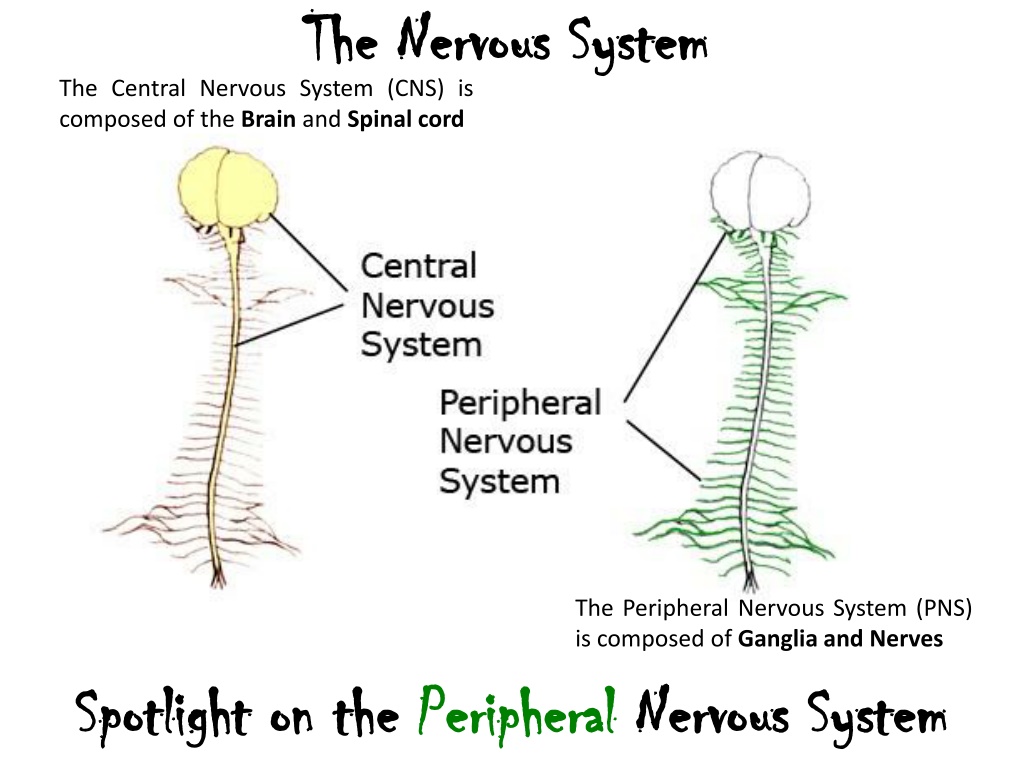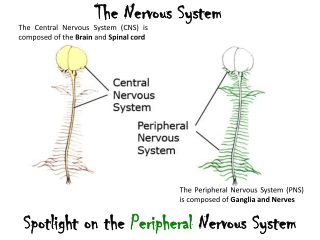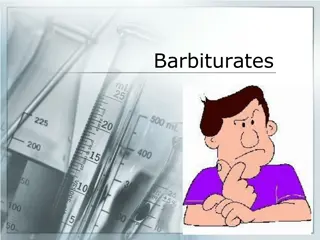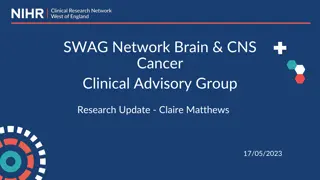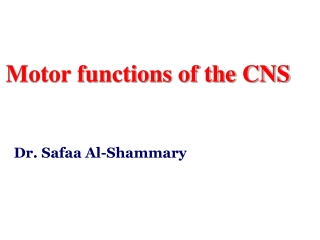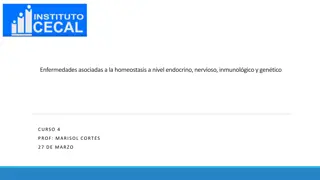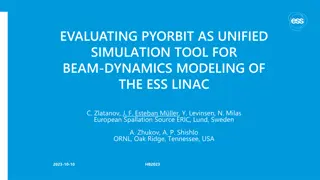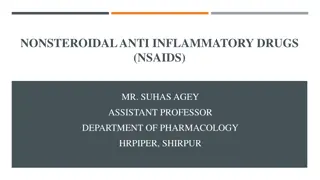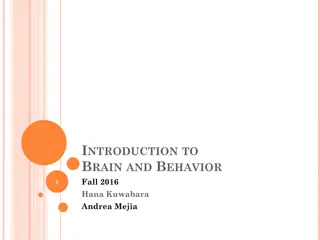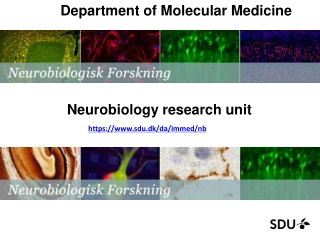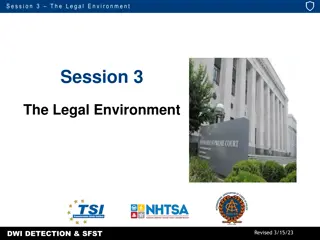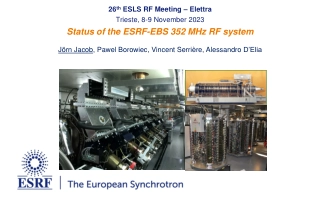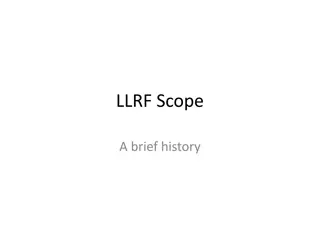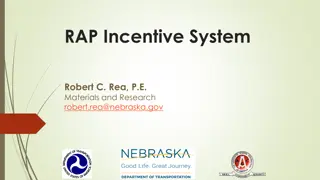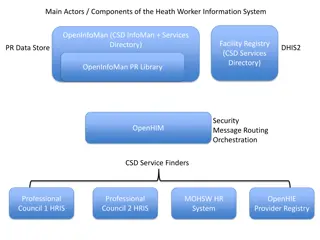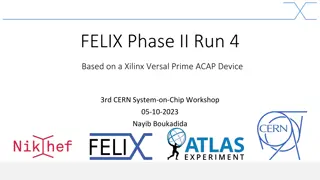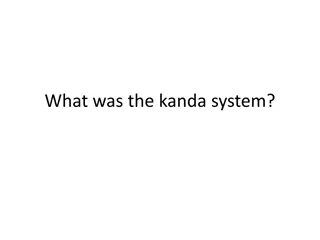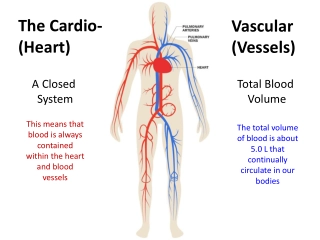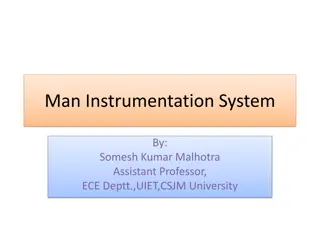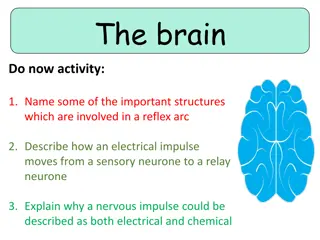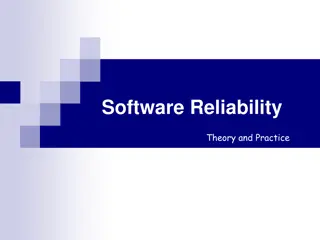Understanding the Nervous System: CNS, PNS, SNS, and ANS
The nervous system comprises the Central Nervous System (CNS) and Peripheral Nervous System (PNS), with the PNS further divided into the Somatic Nervous System (SNS) and Autonomic Nervous System (ANS). The SNS controls voluntary movements of skeletal muscles, while the ANS regulates involuntary processes such as heart rate and digestion. Key concepts include the simple structure of the SNS and the complexity of the ANS, each affecting different types of effector tissues through specific neurotransmitters and receptors.
Download Presentation
Please find below an Image/Link to download the presentation.
The content on the website is provided AS IS for your information and personal use only. It may not be sold, licensed, or shared on other websites without obtaining consent from the author. Download presentation by click this link. If you encounter any issues during the download, it is possible that the publisher has removed the file from their server.
Presentation Transcript
The Nervous System The Nervous System The Central Nervous System (CNS) is composed of the Brain and Spinal cord The Peripheral Nervous System (PNS) is composed of Ganglia and Nerves Spotlight on the Spotlight on the Peripheral Peripheral Nervous System Nervous System
Central Nervous System Central Nervous System Peripheral Nervous System Peripheral Nervous System The PNS has 2 components: The SNS and the ANS Autonomic Nervous System (ANS) Somatic Nervous System (SNS) (has 2 divisions) Voluntary* Involuntary# Effector Tissue is: Skeletal Muscle Only! Parasympathetic Sympathetic Effector Tissues are: 1. Cardiac Muscle 2. Smooth Muscle 3. Glands *Except for Reflexes #Except for Biofeedback
The Somatic Nervous System (SNS) This one is simple and easy This one is simple and easy so let it be! PNS so let it be! CNS One Somatic Motor Neuron to a single effector tissue: Effector Tissue Skeletal Muscle All that ever happens is that a All that ever happens is that a Somatic Motor Neuron to skeletal muscle fibers and then the muscle to skeletal muscle fibers and then the muscle contracts Somatic Motor Neuron fires a signal contracts! ! fires a signal If they do not send a signal, the muscle stays relaxed! e.g., the radial nerve sends a signal and presto, the triceps brachii contract! Easy, huh?
Summary Notes on SNS: Summary Notes on SNS: The Somatic Nervous System (SNS) is simple anatomically. It is mostly under Voluntary control, meaning we are consciously aware of body movement. (The exception is reflex actions) Here are the important concepts of SNS: There is only 1 Somatic Motor Neuron. It acts on 1 Effector Tissue only = Skeletal muscle. Skeletal muscle contracts as a result of this innervation. Skeletal muscle relaxes when there is no signal from somatic motor neurons. We will not go into details about neurotransmitters and receptors, but At the neuromuscular junction for skeletal muscle, somatic motor neurons release ACh on to nicotinic receptors. Skeletal muscles are innervated (controlled by) nerves, when a signal is sent, the muscle contracts. When there is no signal, muscle relaxes.
The Autonomic Nervous System The Autonomic Nervous System (the ANS is more complex than the SNS!) CNS PNS Effector Tissue R is Nicotinic NT is ACh NT is ACh R is Muscarinic and NT is NE R is Nicotinic NT is ACh R s are and The ANS is mostly The ANS is mostly involuntary 2 2 Motor Neurons going to Motor Neurons going to 3 3 types of Effector Tissue involuntary and involves and involves types of Effector Tissue
ANS Notes: ANS Notes: The Autonomic Nervous System (ANS) is complex. It has 2 divisions: The Parasympathetic and the Sympathetic. There are 3 basic effector tissues in the ANS: cardiac muscle, smooth muscle and glandular tissue. So both divisions have the same effector tissues, but often the 2 divisions have antagonistic (opposing) effects. The catch phrase for Para is: Rest and Digest . For Symit s: Fight or Flight . Keep those terms in mind as they help reveal what the actions are on effector tissue. The ANS involves 2 motor (efferent) neurons; The 1st neuron is from the CNS to a ganglion (called the preganglionic neuron) and the 2nd neuron is from the ganglion to the effector tissue (called the postganglionic neuron). A ganglion is a cluster of nerve cell bodies in the PNS. A nerve fiber is a single axon. Right? : ) In the detailed drawings, please notice how the ganglia in the Para division are close to the effector tissue, but in the Sym division they are close to the CNS. Also, notice the nerve fibers (axons) for the preganglionic neurons in the Para are very long and the nerve fibers for the postganglionic are very short. It is the opposite arrangement for the Sym division! What do you notice about axon myelination?
PNS CNS Tissue Preganglionic Neurons PARA e.g., the Heart (Causes decrease) SYM e.g., the Heart (causes increases) Postganglionic Neurons At Ganglion (in PNS): Postganglionic Nerve cell bodies Effector Tissue (in PNS): Cardiac Muscle Smooth Muscle Glands In CNS: Preganglionic Neurons Para = Craniosacral Origin* Sym = Thoracolumbar Origin* Note that the same actions occur at the ganglion for both divisions, they are identical. Here at the effector tissue is where the 2 divisions (Para and Sym) of the ANS differ. *The term origin means where in the CNS do these first ANS neurons come from.
Summary Notes on ANS: Summary Notes on ANS: The Autonomic Nervous System (ANS) is more complex anatomically. The ANS is mostly under Involuntary control, meaning we are not consciously aware of these responses. (The exception is biofeedback actions) Here are the important concepts of ANS: There are 2 Motor Neurons in the ANS: The preganglionic neuron The postganglionic neuron Acts on 3 Effector Tissues: Cardia muscle of the heart. Smooth muscle of blood vessel walls, ducts, tracts and organs. Glands of exocrine (sweat, salivary, etc.) and endocrine (hormones, etc.) glands. There are 2 divisions of the ANS, the Parasympathetic and the Sympathetic For the most part they oppose each other: Para is for resting and digesting, and Sym is for fast emergency responses to prepare the body for danger or excitement.
ANS Notes: ANS Notes: In general, Para is for housekeeping activities ( Rest & Digest ), storing needed things, relaxing, getting rid of things and doing some chores! e.g., after lunch, as you decide to sit and read - Para is at work! Heart rate is low, saliva and G.I. tract activity is high, bronchiole (airways) diameter is small, no need for much air, everything is fine, there s no hurry, you ve got all day. Pupil diameter is small too, enabling that fine focus to get all the details for near focus! In general, Sym is for emergency situations ( Fight or Flight )! You may have to fight or run either way it takes a lot of energy. e.g., imagine as you sit down to read, a big scary creature enters the room. Presto - immediately the Sym is at work. Heart rate skyrockets (to pump more blood to body to get you out of danger), your G.I. activity comes to a halt, and bronchioles diameter gets larger, as you need more air flow to either fight or run. More Sweat? Yep. Dry mouth? Yes. Pupil diameter becomes larger too, enabling distant focus so you can see an escape route! You are ready!!! The ANS influences the activity of most tissues and organ systems in the body!
PARA PARA SYM SYM Now let s compare how the 2 s of the ANS Effect the Heart . . . . The neurotransmitter NE is released from Postganglionic Sympathetic neurons, that is, at the effector tissue! The neurotransmitter ACh is released from Postganglionic Parasympathetic neurons, that is, at the effector tissue! Effect? Effect? Effect? Effect? SYM = Fight or Flight SYM = Fight or Flight PARA = Rest and Digest PARA = Rest and Digest
PARA PARA SYM SYM The The Lungs? Lungs? (Bronchioles) (Bronchioles) Diameter of Bronchioles (constriction) Diameter of Bronchioles (dilation) Bronchioles are tiny tubes in the lungs that air flows through What is the direct effector tissue for the bronchioles? Remember, you really only have 3 basic choices!
PARA PARA SYM SYM Vision? Vision? (constriction) (dilation) Hmmm, did you know coconut oil is a natural saturated fat with medium chain fatty acids and is excellent for human health? Good thing I read Note: Similar effects to Sympathetic stimulation are found from being in Love seriously. The pupil is a hole in the center of the iris (colored part) of the eye. It has two sets of intrinsic muscles that can change pupil diameter, which changes the amount of light that hits the retina and photoreceptors.
PARA PARA SYM SYM Saliva Saliva & & Sweat? Sweat? What a tangled web we weave, when our aim is to deceive! Yum, I can just Imagine how nice this will taste! Make sure it s Organic, salvesterols salvesterols are good for you. Note: Not telling the truth will also make you sweat!
PARA PARA Rest and DIGEST SYM SYM G.I. Tract G.I. Tract Or Or Alimentary Alimentary Canal? Canal? Emergency Emergency - no time to digest! DIGEST In G. I. Tract In G. I. Tract Motility Motility In G. I. Tract In G. I. Tract Motility Motility In G. I. Tract In G. I. Tract Secretions Secretions In G. I. Tract In G. I. Tract Secretions Secretions
ANS Notes: ANS Notes: Vascular Smooth Muscle (VSM) is around blood vessel walls and is predominantly controlled by the Sym division of the ANS, causing vasoconstriction and vasodilation. Vasoconstriction = increased BP Blood Vessel Diameter Controls Blood Flow and Pressure Blood vessel Vasodilation = decreased BP Sympathetic postganglionic neurons release norepinephrine (NE) and: a) if (alpha) receptors present = vasoconstriction = Flow, Blood Pressure b) if (beta) receptors present = vasodilation = Flow, Blood Pressure The rule of thumb is: The more Sym stimulation there is, the more constricted blood vessels become (except for blood vessels supplying skeletal muscle!). So this means your blood pressure will go up when you get scared or excited!!!
Blood Vessel Diameter: Mostly controlled by the SYM (usually, more Sym innervation means more vessel constriction - if s receptors) r r - -> > R R - -> > BP BP - -> > flow flow These are the receptors and NE is binding to them, big time! Sympathetic Innervation r = radius of blood vessel R = peripheral resistance BP = Blood pressure These are the same receptors but there is less NE and thus it is not binding to all of them! r r - -> > R R - -> > BP BP - -> > flow flow s = constriction; s = dilation. The vessel above must have which receptors? Alpha!
Please Note: Skeletal muscle is controlled by the Somatic (soma = body) nervous system (SNS), it is not controlled by the Autonomic nervous system (ANS). However, the SNS and the ANS do work together. The blood vessels supplying skeletal muscles have receptors on them, and the sympathetic postganglionic neurons release NE and it binds to these receptors, it causes vasodilation of these blood vessels supplying skeletal muscle this then increase blood flow to skeletal muscles so you can run faster and swing your arms harder! Makes sense, right?! We will not go into details about neurotransmitters and receptors, but At the ganglion, all preganglionic neurons release ACh on to nicotinic receptors. The postganglionic neurons for the Para division release ACh on to muscarinic receptors at the effector tissue. Effect is usually inhibitory. The postganglionic neurons for the Sym division release NE on to alpha or beta receptors at the effector tissue. Effect is usually excitatory.
Diverting Blood Flow is an important strategy! In times of Emergency, this is what the SYM SYM division does!! Sympathetic postganglionic neuron R s = Vasoconstriction* = alpha receptors R s = Vasodilation* = beta receptors *Shuts down blood supply that is unnecessary when in danger. *Opens up blood supply to skeletal muscle when in danger or exercising. What s the Effector Tissue for blood vessels? Note: The ANS does not innervate Skeletal Muscle!
PARASYMPATHETIC *The PARA division has no effect on blood vessels or blood flow, Except to erectile tissue! Here it causes vasodilation which we know increases blood flow to a region. Parasympathetic postganglionic neuron Erectile tissue of clitoris for females to vasodilation blood vessels to erectile tissue Yep Yep > Engorged and Tingly > Engorged and Tingly Erectile tissue of penis for males vasodilation to
SYMPATHETIC The SYM division acts on the tracts and ducts of the Reproductive System Lining of Repro tract Lining of Repro tract Yep Yep > Ejection of Fluids > Ejection of Fluids Lining of Repro duct Lining of Repro duct Q: What s the Effector Tissue that lines these ducts? Only have 3 basic choices!
Notes: Notes: To Summarize, in matters of Reproduction Para relaxes VSM* and increases blood flow to erectile tissue = the point factor. Sym causes the smooth muscle of reproductive ducts to contract = the shoot factor. *VSM = vascular smooth muscle (the muscle around blood vessels) The Anatomical Arrangement of two divisions is indicative of their function. The Para division is more Convergent, such that it often focuses on one thing at a time, like only one effector tissue, not 4 at once. Usually, the Paraganglion is very close to or on the effector tissue, so it is a focused response, it is not wide-spread. The Sym division is more Divergent, such that it can signal multiple tissues at once. With the Sym ganglion so close to the spinal cord, this allows the response to be wide-spread, branching out into many directions at once (simultaneously).
Anatomical Arrangement of ANS Anatomical Arrangement of ANS Para Para is is CONVERGENT CONVERGENT Ganglion Effector Tissue Sym Sym is is DIVERGENT DIVERGENT Ganglion Effector Tissue
Table of Actions of the 2 Divisions of the Autonomic Nervous System Effector Tissue Parasympathetic Sympathetic Iris (Eye Muscles) Pupil Constriction Pupil Dilation Lacrimal Gland Increase sections (tears) ------------- Sweat Glands ------------- Increased sections Lung Bronchioles Bronchial constriction (decreased air flow) Decreased Heart Rate Decreased Force of Beat Bronchial dilation (increased air flow) Increased Heart Rate - Increased Force of beat - Vasoconstriction - Vasodilation - Heart Blood Vessels of the Body ------------- Salivary Glands Increased Watery Saliva Reduced Watery Saliva G. I. Tract Activity Increased Motility Increased Secretions Decreased Motility Decreased Secretions Liver Glycogen synthesis Glycogen breakdown Bladder Wall Contraction ------------- Adrenal Medulla ------------- Epinephrine secreted into blood as a hormone ------------- Erectile Tissue Stimulation of blood flow (vasodilation of blood vessels) ------------- Reproductive Tract Stimulation of contraction -------- means no effect
